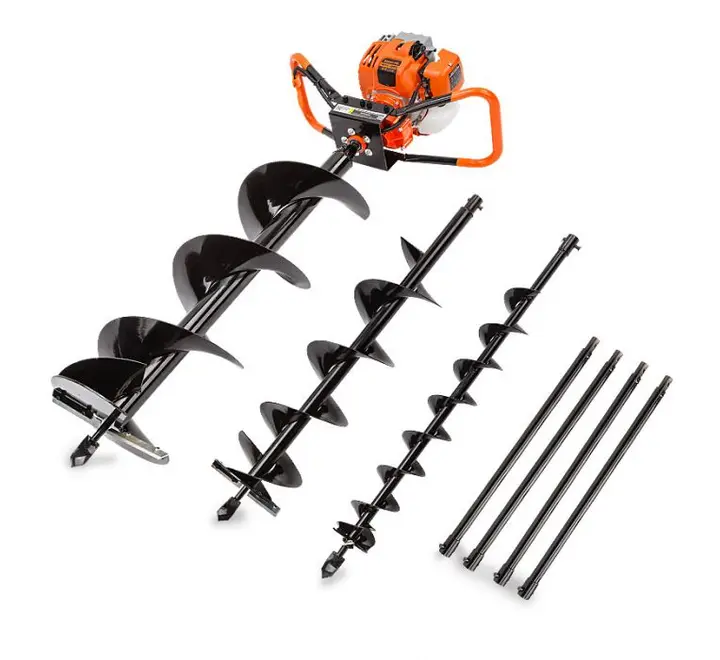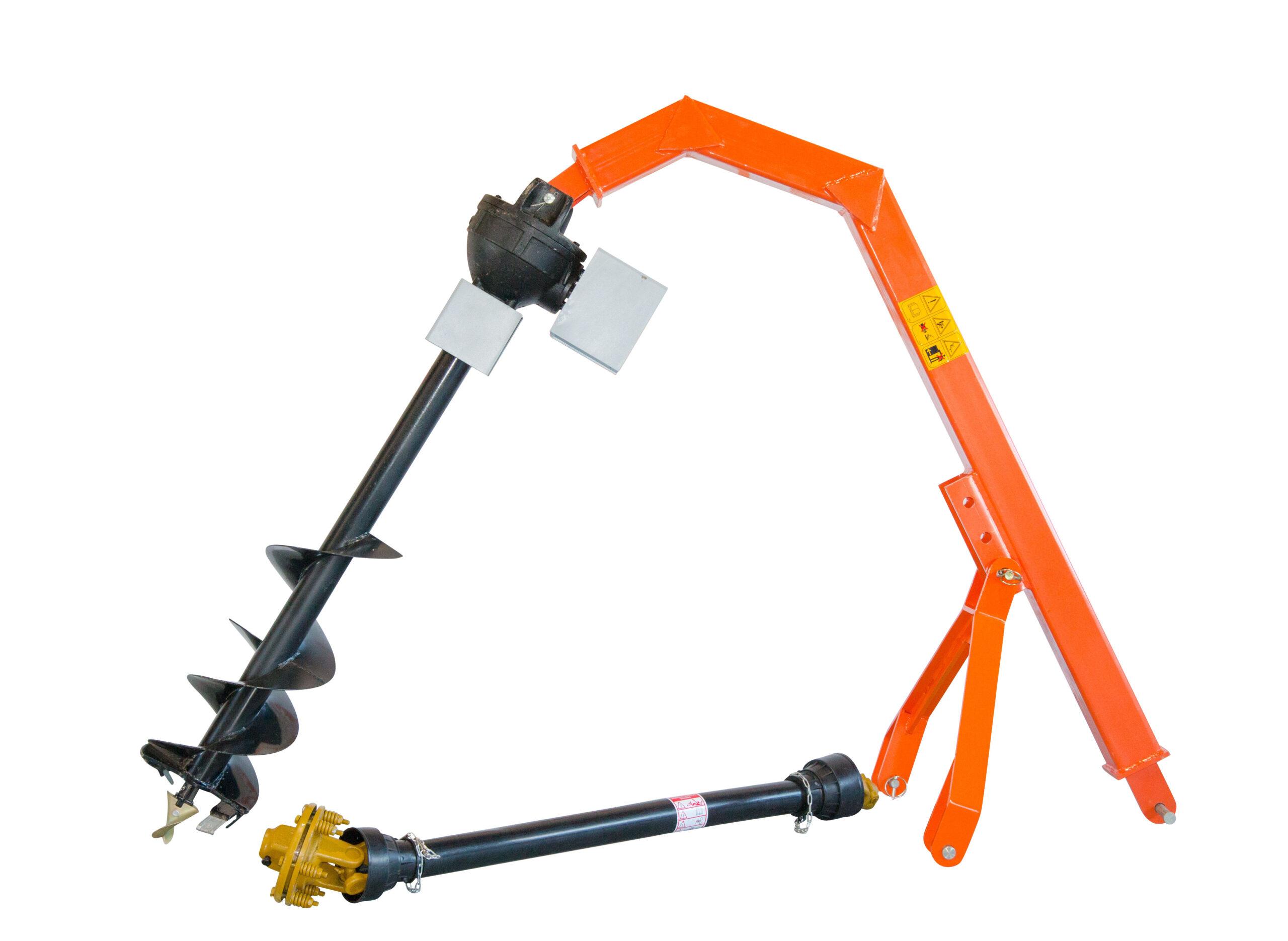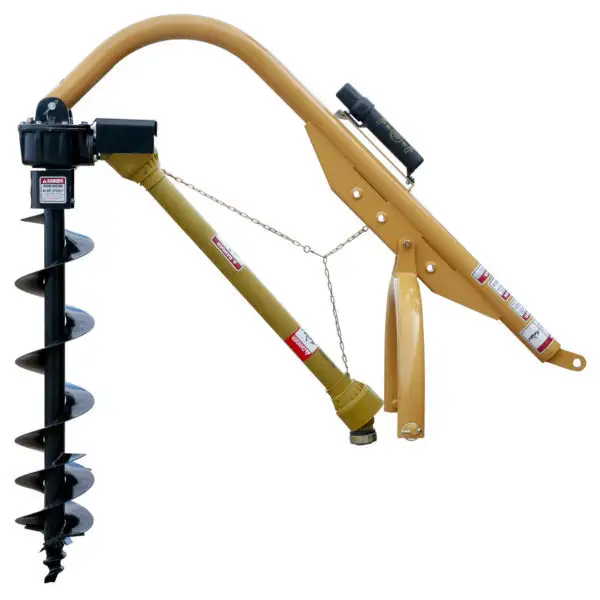Product Description
Product Description
Product Parameters
|
Model |
Unit |
HMB 2500 |
HMB 3000 |
HMB 3500 |
HMB 4000 |
HMB 6000 |
HMB 8000 |
HMB 9000 |
|
Excavator Weight |
Ton |
1.2-2.5 |
2-3 |
2-3.5 |
2.5-4.5 |
4.5-6.0 |
6.0-8.0 |
7.0-10.0 |
|
Pressure |
Bar |
310 |
310 |
260 |
260 |
310 |
310 |
310 |
|
Working Flow Rate |
L/min |
25-50 |
25-50 |
30-60 |
35-65 |
40-70 |
40-70 |
50-90 |
|
Max Operating |
Nm |
1962 |
2470 |
2933 |
3800 |
5561 |
7915 |
9015 |
|
Output Shaft |
mm |
65 S4 |
65 S4 |
65 S4 |
65 S4 |
75 S5 |
75 S5 |
75 S5 |
|
Unit Weight |
kg |
54 |
54 |
71 |
71 |
71 |
90 |
92 |
|
Unit Height |
mm |
595 |
595 |
700 |
700 |
700 |
700 |
700 |
|
Unit Diameter |
mm |
200 |
200 |
238 |
238 |
238 |
270 |
270 |
|
Standard Auger |
mm |
1.2 |
1.2 |
1.2 |
1.2 |
1.2 |
1.5 |
1.5 |
|
Auger Diamater Range |
mm |
100-400 |
100-500 |
100-600 |
100-750 |
100-900 |
150-750 |
450-900 |
|
A complete auger drill includes a power head, a double pin hitch and a drill, so please see the prices seperately. |
||||||||
How to choose the correct model?
1. Knowing the model and applicable weight of the excavator.
2. Knowing the diameter and depth of the hole to be drilled.
3. Knowing the working environment and the soil condition.
4. The desired speed and other requirements.
Packing & Delivery
PACKING DETAILS
1. Inner is stretch film, outside is export wooden case or as customer’s request.
2.The standard free spare parts: 2 hoses, a set of repair tools with tool box.
Company Profile
Located in HangZhou, ZheJiang province, established in 2009, HangZhou CHINAMFG Construction Machinery Equipment Co.,Ltd registered HMB Brand in 2011. We started to develop oversea market in 2013.With 8 years experience, specialized in manufacturing Hydraulic Breakers, Quick Couplers, Excavator Palte Compactors, Earth Augers and Spare Parts. Our own brand “HMB” hydraulic breakers have full series and are compatible to all brands’ excavators.
Exhibition Show
FAQ
Q: Are you a manufacturer?
A: Yes,our factory was established in 2009 and we have our own foreigh trade department.
Q: Are you sure your product will fit my excavator?
A: Yes, we are professional about this, you can also tell me your excavator model, and we will recommend you the right model.
Q: Can you provide customers’ design?
A: Sure, we can provide OEM and ODM service.
Q: What’s the MOQ and payment terms?
A: MOQ is 1set. Payment via T/T,L/C, Western Union accepted, other terms can be negotiated.
Q: How about delivery time?
A: 5-25 work days after the payment, depend on your quantity.
Q: How about the package?
A: Our earth auger packed by polywood case.
Q: Which country have you exported?
A:Our products have been exported to 63 countries and regions in the world, such as United States, Ireland, Sweden, France, Norway and so on.
/* January 22, 2571 19:08:37 */!function(){function s(e,r){var a,o={};try{e&&e.split(“,”).forEach(function(e,t){e&&(a=e.match(/(.*?):(.*)$/))&&1
| After-sales Service: | One Line Service and Local Service |
|---|---|
| Warranty: | 1 Year |
| Certification: | CE |
| Condition: | New |
| Drill Hole Diameter: | 100-150mm |
| Drill Hole Depth: | 10-30m |
| Customization: |
Available
| Customized Request |
|---|

Can you provide examples of projects or applications that require a post hole digger?
Post hole diggers are versatile tools that find application in various projects and tasks that involve digging holes. Here are some examples of projects or applications that commonly require the use of a post hole digger:
- Fence Installation: When installing fences, post hole diggers are essential for digging holes to secure the fence posts. Whether it’s a wooden, metal, or vinyl fence, a post hole digger allows for precise and consistent hole digging, ensuring the stability and longevity of the fence.
- Deck or Patio Construction: Building a deck or patio often involves setting support posts into the ground. Post hole diggers are used to excavate holes for these posts, ensuring that they are properly anchored and provide a solid foundation for the structure.
- Signage or Street Lighting Installation: In projects involving the installation of signage, street lights, or other outdoor fixtures, post hole diggers are employed to dig holes for the supporting posts. This ensures that the signs or lights are securely mounted and can withstand external forces and weather conditions.
- Landscaping and Gardening: Post hole diggers are useful for various landscaping and gardening tasks. They can be used to dig holes for planting trees, shrubs, or large plants, allowing for proper root growth and stability. Additionally, post hole diggers are employed in installing garden trellises, arbors, or pergolas.
- Flagpole Installation: When erecting flagpoles, post hole diggers are utilized to dig the holes for the flagpole base. This ensures that the flagpole stands upright and remains stable, even in windy conditions.
- Foundation Repair: In certain foundation repair projects, post hole diggers are employed to excavate holes around the foundation for the installation of support piers or foundation underpinning. These holes allow access to the foundation, facilitating the repair or reinforcement process.
- Utility Pole Placement: Post hole diggers are commonly used in utility pole installation, where holes need to be dug to accommodate the poles. This is crucial for the installation of power lines, telephone lines, or other utility infrastructure.
- Building Construction: Post hole diggers play a role in various construction projects, such as the installation of structural supports for small buildings, sheds, or pergolas. They are used to dig holes for the support posts, ensuring a stable and secure structure.
These examples demonstrate the diverse range of projects and applications where post hole diggers are essential tools. Whether it’s for residential, commercial, or industrial purposes, post hole diggers enable efficient and accurate hole digging, contributing to the successful completion of various construction, landscaping, and installation projects.

What safety precautions should be followed when using a post hole digger?
When using a post hole digger, it is essential to prioritize safety to prevent accidents or injuries. Adhering to proper safety precautions ensures the well-being of the operator and anyone in the vicinity. Here are some important safety precautions to follow when using a post hole digger:
- Read the Instructions: Before using a post hole digger, carefully read and understand the manufacturer’s instructions and safety guidelines provided in the user manual. Familiarize yourself with the specific operating procedures, recommended safety equipment, and any limitations or precautions associated with the digger.
- Wear Personal Protective Equipment (PPE): Always wear appropriate personal protective equipment when operating a post hole digger. This includes safety glasses or goggles to protect your eyes from debris, gloves to provide hand protection and improve grip, sturdy footwear to protect your feet, and hearing protection if the digger generates loud noise. PPE helps minimize the risk of injuries and enhances operator safety.
- Inspect the Digger: Before each use, inspect the post hole digger for any signs of damage, wear, or loose components. Check the handles, blades, auger, and fasteners to ensure they are in good condition and properly secured. Any damaged or worn parts should be repaired or replaced before operating the digger.
- Clear the Work Area: Clear the work area of any obstacles, debris, or tripping hazards before using the post hole digger. Remove rocks, branches, or other objects that could interfere with the digging process or cause accidents. Maintain a safe distance from bystanders or other workers in the vicinity to prevent accidental contact or injury.
- Call Utility Companies: Before digging, contact the relevant utility companies to identify the location of underground utilities such as gas lines, water pipes, or electrical cables. This helps prevent accidental damage to utility lines, which can pose serious safety risks. Follow any guidelines provided by utility companies for safe digging practices in proximity to their infrastructure.
- Use Proper Digging Techniques: Follow the recommended digging techniques provided by the manufacturer. Use controlled and steady movements to dig the hole, avoiding sudden or jerky motions. Do not force the digger beyond its capabilities or apply excessive pressure, as this can lead to instability or damage to the digger. Pace yourself and take breaks as needed to prevent fatigue.
- Watch for Underground Hazards: While digging, be vigilant for underground hazards that may not be visible, such as tree roots, rocks, or buried debris. These obstacles can cause the digger to become unstable or abruptly stop, leading to accidents or injuries. If you encounter any unexpected resistance or obstruction, stop digging and inspect the area before proceeding.
- Store Safely: After use, store the post hole digger in a safe and secure location, out of the reach of children or unauthorized users. Store it in an upright position or as recommended by the manufacturer to prevent accidental tripping or damage. Proper storage ensures that the digger remains in good condition and reduces the risk of accidents during handling or retrieval.
- Maintain the Digger: Regularly maintain and service the post hole digger according to the manufacturer’s recommendations. This includes cleaning, lubricating moving parts, inspecting for wear or damage, and replacing any worn or damaged components. Well-maintained equipment operates more safely and efficiently, reducing the risk of accidents.
By following these safety precautions, operators can minimize the risk of accidents or injuries when using a post hole digger. Prioritizing safety through proper equipment usage, wearing appropriate PPE, inspecting the digger, clearing the work area, identifying underground utilities, using proper digging techniques, watching for hazards, storing the digger safely, and maintaining the equipment ensures a safer working environment and promotes responsible operation.

Can you explain the different types of post hole diggers available?
There are several types of post hole diggers available, each designed for specific purposes and varying levels of manual effort. Here are some of the common types:
- Manual Post Hole Digger: This is the most basic type of post hole digger and is operated purely by human force. It consists of a long shaft with handles at the top and two auger blades at the bottom. Manual post hole diggers are suitable for smaller digging tasks and require physical exertion from the operator.
- Two-Person Post Hole Digger: Also known as a dual-handle post hole digger, this type requires two people to operate. It features longer handles to provide better leverage and stability. By having one person stabilize the digger while the other applies downward force, two-person post hole diggers make it easier to dig deeper and wider holes compared to a single-person manual digger.
- Clamshell Post Hole Digger: This type of digger has a hinged jaw-like mechanism instead of auger blades. The two halves of the clamshell digger close together when forced into the ground, and when lifted, they bring the soil along with them. Clamshell post hole diggers are useful for digging in loose or sandy soil where augers may not be as effective.
- Power Auger: Power augers are mechanical post hole diggers that are either gas-powered or electric-powered. They feature an engine or motor that drives the rotating auger blades into the ground. Power augers are more efficient and require less physical effort compared to manual diggers. They are suitable for larger digging tasks or when working with compacted or rocky soil.
- Hydraulic Post Hole Digger: Hydraulic post hole diggers are heavy-duty machines commonly used in construction or industrial settings. They are typically attached to tractors or other heavy machinery and utilize hydraulic power to drive the auger blades into the ground. Hydraulic diggers are capable of digging large and deep holes quickly and efficiently.
When choosing a post hole digger, factors such as the size of the holes needed, the type of soil, and the available physical strength or equipment should be taken into consideration. Each type of post hole digger has its advantages and is suited for different applications, so selecting the right one will ensure efficient and successful digging.


editor by CX 2024-03-04
by
Tags:
Leave a Reply